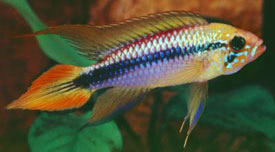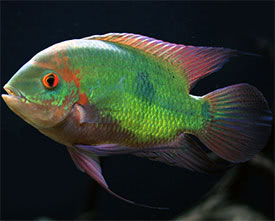Uaru amphiacanthoides - Uaru
 Magyarul / Hungarian
Magyarul / Hungarian

 Magyarul / Hungarian
Magyarul / Hungarian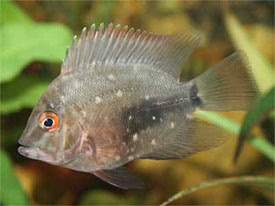
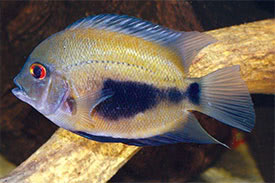
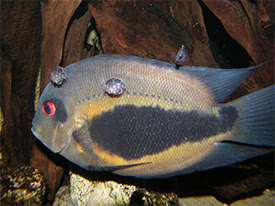
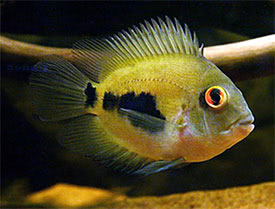
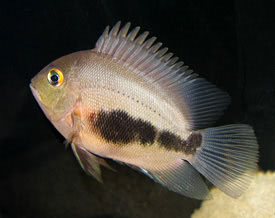
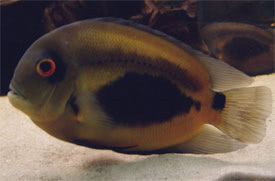
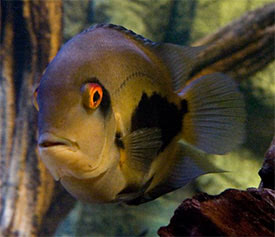

- Scientific name: Uaru amphiacanthoides
- Synonyms: Pomotis fasciatus (Jardine, 1843), Uaru obscurum (Günther, 1862), Acara imperialis (Steindachner, 1879)
- Common name: Uaru
- Group: Cichlids
- Distribution: South America; Amazon basin in northern Brazil and Guyana. From the Rio Japurá to Rio Tapajós, and both in the middle to lower Rio Negro rivers.
- Size: 25-30 cm
- Biotope: Found in clear water tributaries, often around submerged branches or tree roots, and also in calm parts of small, blackwater rivers.
- Social behavior: Quite peaceful and friendly for such a large cichlid that can be safely housed with smaller or larger fish, but can be territorial during spawning and will violently defend its young if necessary. They live in small groups in the wild. Tankmates can be Angels, eartheaters and larger tetras.
- Diet: Omnivorous; stomach analyses of wild fish have revealed that they eat a substantial amount of plant matter along with invertebrates and freshwater sponges. In aquarium they diet should be primarily vegetable matter, but should also include some protein. Their favorite meaty foods are bloodworm, earthworm, and tubifex.
- Breeding: Hard
- Tank: Minimum 300 litres
- Population: 1 pair for 500 litres
- Decoration: Decorate their aquarium with tree branches, roots and larger stones, however they usually eat aquatic plants. Floating plants or fast growing plants can be used as they can help to diffuse the lighting, and are also a great food source for the fish. The substrate can be small gravel or fine sand.
- Temperature: 26-30 °C
- pH: 5.5-7.0
- Hardness: 1.0-12.0 dGH
- Lifespan: 8-12 years
Description: Uaru has an oval, disc-shaped, laterally compressed body. The adult fish isn't very spectacularly colored, the body is usually slate gray to silver, and the belly and throat regions may be pinkish. There is a large greenish-black area on the lower parts of the midsection, and above this area there is a fine dotted line which extends from the gill cover to the rear area of the body. A black spot at the caudal penuncle is characteristic of this species. During the breeding period the whole sides of the cichlid become black, leaving just a hint of brown around the edges. Juvenile fish have a yellow colored body with white dotts, and there is a dark shade near the belly which will eventually develop into the teardrop shape mentioned above. As they reach a size of roughly 5-7 cm, the young ones begin to loose the white dots and become more like their parents. All the fins except the pectorals are dark, the anal and dorsal fins are pointed and there are often opalescent blue lines along their edges, while the caudal fin is fan-shaped. The iris of the eye is amber-gold to red in color and the rear half of the eye is surrounded by a black marking. The mouth of Uaru is relatively small and equipped with numerous small teeth, which in the aquarium usually serve to scrape wood that may aid their digestive process. In the wild they can reach a length of 35 cm. In their natural habitat, Uaru are a beloved food source for the locals. Most Uaru amphiacanthoides in the hobby come from German and Indonesian commercial breeders. They grow very quickly if fed properly. A few dozen years ago, when discus were rare and expensive in the aquarium trade, Uaru were considered a cheap substitute and therefore often called "the poor man's discus". Their shape, reproduction and requirements are similar, so people who couldn't afford the discus of their dreams would settle for the Uaru.
It is very hard to sex Uaru cichlids based on external characteristics, males have more pointy genital papillae and can develop a fatty hump behind the head. It is also thought that red eyes occur almost entirely in females, though both males and females can also have orange eyes, but neither of these are foolproof. If you wish to breed Uaru amphiacanthoides, the easiest method is normally to raise a group of 6-8 young fish together and let them do their own pairing.
Breeding is hard, use very soft (2-4 dGH) and slightly acidic (pH 6) water with a temperature of 28-30 °C. The number of the eggs can vary between 100 and 300, although reports of much larger batches do exist. The female will deposit her eggs on the substrate or on a flat surface, such as a flat stone, or on similar protected area. Both parents guard the eggs which hatch in 2-4 days and are then the larvae moved by their parents to a spawning pit dug out in the substrate. They stay in the pit until they become free swimming 3-4 days later. The fry - like Discus - feed on a milk-like secretion produced by the skin of both parents. After a period of 9-12 days, the fry should be removed so as not to overfeed on the parents' secretion. At that time, start feeding them with small live foods. The fry are very delicate and difficult to rear. Don't be affraid if your Uaru couple eat eggs during the first initial spawning, because it is common among young parents. When a pair refuse to reproduce, there are a few methods of inducing them to breed. One of them is a change of decor in the aquarium, sometimes you just need to put in a new piece of driftwood, or rearrange the existing decorations, and the fish will soon begin to spawn. Another method is generous feeding, changing water chemistry to make if softer and more acidic, and raising the temperature by 2° to 3°. If these methods fail, you can try a more elaborate scheme: discontinue water changes for a month, lower the water level to one-third of the tank's height, and feed the fish sparingly. Then make 2 or 3 10 to 20 percent water changes every 2 to 3 days, using very soft and acidic water, followed by one more large change (two-third of the water). Finally, top up the aquarium and start feeding the fish well, at the same time raising the temperature to 31-32 °C.
Sources:
http://www.fishbase.org/summary/Uaru-amphiacanthoides.html
http://www.seriouslyfish.com/species/uaru-amphiacanthoides/
http://badmanstropicalfish.com/profiles/profile105.html
http://www.aquaticcommunity.com/cichlid/uaru.php
http://animal-world.com/encyclo/fresh/cichlid/UaruCichlid.php
http://fish.mongabay.com/species/Uaru_amphiacanthoides.html
Tropical Fish Hobbyist 2013.06.
http://www.fishbase.org/summary/Uaru-amphiacanthoides.html
http://www.seriouslyfish.com/species/uaru-amphiacanthoides/
http://badmanstropicalfish.com/profiles/profile105.html
http://www.aquaticcommunity.com/cichlid/uaru.php
http://animal-world.com/encyclo/fresh/cichlid/UaruCichlid.php
http://fish.mongabay.com/species/Uaru_amphiacanthoides.html
Tropical Fish Hobbyist 2013.06.
Hasonló vízparamétereket igénylő fajok









